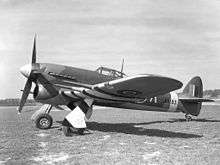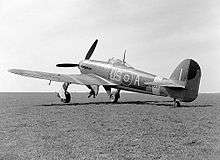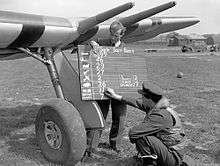No. 56 Squadron RAF
| No. 56 Squadron RAF | |
|---|---|
| Active |
8 June 1916 – 22 January 1920 1 February 1920 – 23 September 1922 1 November 1922 – 1975 22 March 1976 – date |
| Country |
|
| Branch |
|
| Role | Operational Evaluation unit |
| Base | RAF Waddington |
| Nickname(s) |
Punjab 'Firebirds' |
| Motto(s) |
Latin: Quid si coelum ruat ("What if heaven falls?") |
| Battle honours | Western Front 1917-1918*; Arras; Ypres 1917*; Cambrai 1917; Somme 1918*; Amiens; Hindenburg Line; France & Low Countries 1940; Dunkirk*: Battle of Britain, 1940*; Fortress Europe, 1942–1944; Dieppe; France & Germany, 1944–1945*; Normandy, 1944*; Home Defence, 1942–1945; Arnhem*.[note 1] |
| Insignia | |
| Squadron Badge Crest | A phoenix- approved by King Edward VIII in July 1936. The phoenix was chosen to underline the Squadron's ability to reappear intact regardless of the odds. |
| Post 1950 Squadron Roundel |
 |
| Squadron Codes |
LR (Sep 1939) US (Sep 1939 – Apr 1946 and 1947 – Dec 1950) ON (Apr 1946 – 1947) (Codes taken over from No 124 Sqn) B (Carried on Phantoms) A (Carried on Tornados) |
Number 56 Squadron is one of the oldest and most successful squadrons of the Royal Air Force, with battle honours from many of the significant air campaigns of both World War I and World War II. As 56 (Reserve) Squadron it is now an operational evaluation unit.
History
First World War
The squadron was formed on 8 June 1916 and was posted to France in April 1917 as part of the Royal Flying Corps. The squadron was equipped with the then brand new S.E.5 fighter. Its arrival at the front with the latest fighter, combined with the unusually high proportion of experienced pilots in its ranks, led to rumours among its German opponents the squadron was specifically the 'Anti-Richthofen Squadron', dedicated to the removal of the Red Baron. Although there was no truth in these rumours, the squadron did shoot down and kill Richthofen's nearest 1917 rival Leutnant Werner Voss in an epic dogfight.
By the end of the war 56 Squadron had scored 402 victories (as 'destroyed', 'out of control' or 'driven down'), and many famous fighter aces served with the unit, such as James McCudden, Reginald Hoidge, Gerald Constable Maxwell, Arthur Rhys Davids, Geoffrey Hilton Bowman, Richard Maybery, Leonard Monteagle Barlow, Henry Burden, Cyril Crowe, Maurice Mealing, Albert Ball, William Roy Irwin, Edric Broadberry, Kenneth William Junor, Cecil Lewis, Keith Muspratt, Harold Walkerdine, William Spurrett Fielding-Johnson, William Otway Boger, Charles Jeffs, Harold Molyneux, and Duncan Grinnell-Milne, the latter of whom became the unit's last Commanding Officer before the squadron was disbanded. During the course of the war, forty of the squadron's pilots were killed in action, twenty wounded and thirty-one taken prisoner.[1]
Between the Wars
The squadron was disbanded and reformed several times between the wars.
Only days after being disbanded 22 January 1920, 80 Squadron was renumbered 1 February 1920 to 56. The squadron was disbanded again 23 September 1922; however, one Flight was hastily reformed on 26 September and sent to Turkey for the Chanak Crisis. This flight was officially attached to 208 Squadron and remained in Turkey until August 1923. However it continued to use the 56 numberplate, even though the Squadron had reformed officially in November 1922 at RAF Hawkinge.
The squadron finally settled at RAF North Weald in 1927, where it remained until the end of 1939 and the start of the Second World War.[2]
Equipment included:
- Sopwith Snipes (1 February 1920 – 1924)[3]
- Gloster Grebes (September 1924 – September 1927),
- Armstrong Whitworth Siskins (September 1927 – October 1932),
- Bristol Bulldogs (October 1932 – May 1936),
- Gloster Gauntlets (May 1936 – July 1937),
- Gloster Gladiators (July 1937 – May 1938),[4]
- Hawker Hurricane Is (May 1938).
 56 Sqn. Armstrong Whitworth Siskin, RAF North Weald.
56 Sqn. Armstrong Whitworth Siskin, RAF North Weald. 56 Sqn. Bristol Bulldog, RAF Mildenhall, July 1935.
56 Sqn. Bristol Bulldog, RAF Mildenhall, July 1935.
Second World War
No. 56 Squadron's introduction to the war came on 6 September 1939. The squadron, then based at RAF North Weald, were the victims of a friendly fire incident known as the Battle of Barking Creek.[5] Two pilots of the squadron were shot down and one, P/O Montague Hulton-Harrop, was killed, becoming the RAF's first casualty in the defence of the UK.[note 2]

The squadron entered the Second World War equipped with the Hawker Hurricane and first saw action during the Battle of France, although they remained based in England and sent flights to France for short periods. The squadron ended the campaign by covering the Dunkirk evacuation. As part of No. 11 Group RAF, the squadron was based at North Weald, when the squadron first engaged German aircraft on 31 July 1940. It was heavily involved in the fighting in the south of England during August, although the squadron moved to RAF Boscombe Down at the beginning of September. It was one of the few fighter squadrons to remain based in the south of England continuously through the battle.
Based at RAF Duxford and operating Hurricanes, it recommenced missions in 1941 as an Indian 'gift' squadron[6] over the continent, including escorting bombers raiding targets in German-occupied France. In September 1941 the squadron became the first unit to receive the Hawker Typhoon which, although troublesome to begin with, the squadron helped turn into a usable fighter. Throughout 1942 and 1943 the unit was based with No. 12 Group RAF at RAF Matlaske in Norfolk. During this time 56 Squadron's role changed from that of low-level defence against Fw 190 and Bf 109 fighter-bomber attacks into becoming fighter bombers themselves, attacking ground and sea targets. 56 Squadron was to score one confirmed victory on Typhoons.[7]
In 1944 the squadron moved to RAF Newchurch and converted to the Hawker Tempest Mk.V. S/L Higginson left the squadron at this time, due to his knowledge of the pilot escape routes in France; his total victory count, all with No. 56, was 15.
As a unit of No. 150 Wing RAF, under the command of Wing Commander Roland Beamont, 56 Squadron was an air defence squadron, involved in defending Britain from V1 flying bombs. Between 70 and 77 1⁄2 of these were shot down before a transfer to advance landing ground B.60 at Grimbergen in Belgium on 28 September as part of 122 Wing,[note 3] Second Tactical Air Force. During subsequent operations 56 Squadron was to become equal highest scoring Tempest unit, with 486(NZ) Sqn, totalling 59 confirmed victories.
During the Second World War the squadron claimed a total of 149 aircraft shot down.[8]
- Hawker Typhoons of 56 Sqn.
In April 1943 Charles E Brown from aviation journal Flight visited 56 Sqn. at Matlaske
 |
 US-A. Special 18-inch-wide (460 mm) identification stripes were painted on the upper wings |
 Two flights in formation. Sqn Ldr Pheloung leads in US-A. By 1943 these "vics" of three were only used to impress photographers. This photo appeared in 'Flight', 6 January 1944. | |
Cold War
The squadron converted to the RAF's first jet fighter, the Gloster Meteor F.III, in April 1946 at RAF Bentwaters where they also flew the Gloster Meteor F.8 and the Supermarine Swift. In 1952 and 1953 56 Squadron flew the Meteor VIII from RAF Waterbeach receiving the Swift for evaluation in 1953 until 1955. In September 1957 the squadron moved to RAF Wattisham with the Hawker Hunter F5/F6 where they would spend some 35 years defending UK airspace, intercepting Tupolev Tu-95 "Bear" aircraft.
They converted to the English Electric Lightning F1A in 1960 and showed the aircraft in a display team called "The Firebirds". The squadron left Wattisham in 1967 deploying to RAF Akrotiri in Cyprus, before returning in 1975 with the Lightning F6.
In 1976 56 Squadron exchanged their Lightnings for McDonnell Douglas Phantom FGR.2s and shared their base of RAF Wattisham initially with 23 Squadron and subsequently, on their departure to the Falkland Islands in 1982, with 74 Squadron. Both 56 and 23 Squadron operated the Phantom FGR.2, which used Rolls Royce Spey engines, UK MOD Radar systems and other RAF modifications. 74 Squadron was equipped with ex-US Navy/Marine F-4Js (designated as the F-4J(UK) in RAF service).
56 Squadron operated the Phantom FGR.2 at Wattisham until finally retiring these in 1992. 56 Squadron moved to RAF Coningsby and the following year RAF Wattisham, one of Britain's major fighter bases during the Cold War, was closed and handed over to the British Army.[10]
Modern day
At Coningsby the squadron adopted the title of 56(Reserve) Squadron. It became the RAF's Operational Conversion Unit (229 OCU) conducting training of Ab initio crew and aircrew converting from other aircraft types to the Tornado F3. Following the announcement that the Eurofighter Typhoon would be stationed at Coningsby, it was decided that 56(R) Sqn would relocate to RAF Leuchars in Fife, home to 43(F) Squadron and 111 Squadron (with whom 56 Sqn had previously shared Wattisham), flying the Tornado F3. The Squadron moved north in March 2003, initially moving into the 'Ark Royal' hangar before moving into a new building on the northern side of the airfield.[11] The squadron, nicknamed the Firebirds, was until 2005 the display squadron for the F3. It was announced in December 2005 that, as a cost-cutting measure, the RAF would no longer have a Tornado F3 display .
On 5 February 2008 it was reported that 56(R) squadron would disappear after being merged with 43(F) Squadron on 22 April as the Tornado fleet was to be replaced with the Eurofighter Typhoon. The 56 Squadron nameplate was transferred to the Air Warfare Centre Air Command and Control Intelligence, Surveillance and Reconnaissance Operational Evaluation Unit (AIR C2ISR OEU) at RAF Waddington on 22 April 2008 as 56(R) Sqn. Today, the Squadron provides operational test and evaluation, and specialist advice, for RAF airborne ground surveillance, airborne electronic sensors, airborne command and control, aerospace battle management and intelligence exploitation.[12]
See also
References
- Notes
- Citations
- ↑ http://www.theaerodrome.com/aces/canada/molyneux.php Retrieved 8 February 2010.
- ↑ http://www.56sqnfirebirds.org.uk/squadronhistory.htm 56 Squadron Association - Squadron History
- ↑ RAF Battle of Britain squadrons
- ↑ Gustavsson, Håkan. "Gloster Gladiator in 56 RAF Squadron service". Biplane Fighter Aces from the Second World War. Retrieved 17 April 2013.
- ↑ Ramsay, 1987. Pages 26–33.
- ↑ Singh, Polly. "The Indian Gift Squadrons". bharat-rakshak.com. Retrieved 1 February 2016.
- ↑ Thomas and Shores, 1988
- ↑ Thomas and Shores, 1988
- ↑ Thomas and Shores, 1988. Note: On 20 June 1943, Sqn Ldr Pheloung flying EK184, US-C, was hit by flak and crashed into the sea while attacking shipping.
- ↑ http://www.airsceneuk.org.uk/wattisham A history of RAF Wattisham
- ↑ RAF Leuchars website
- ↑ http://www.56sqnfirebirds.org.uk/squadrontoday.htm 56 Squadron Association - The Squadron Today
- Bibliography
- Beamont, Roland. My Part of the Sky. London, UK: Patrick Stephens, 1989. ISBN 1-85260-079-9.
- Beamont, Roland. Tempest over Europe. London, UK: Airlife, 1994. ISBN 1-85310-452-3.
- Ramsay, Winston G (editor).The Blitz Then and Now; Volume 1. London, UK: Battle of Britain Prints International Limited, 1987. ISBN 0-900913-45-2
- Rawlings, John D. R. Fighter Squadrons of the RAF and their Aircraft. Somerton, UK: Crécy Books, 1993. ISBN 0-947554-24-6.
- Thomas, Chris. Typhoon and Tempest Aces of World War 2. Botley, Oxford, UK: Osprey Publishing, 1999. ISBN 1-85532-779-1.
- Thomas, Chris and Shores, Christopher. The Typhoon and Tempest Story. London: Arms and Armour Press, 1988. ISBN 0-85368-878-8.
External links
| Wikimedia Commons has media related to No. 56 Squadron RAF. |
- Official RAF 56(R) Squadron web page
- 56 Squadron Association website
- Firebirds 56 Sqn RAF
- Flight Global World War 2 archive
- Battle of Britain 54 Sqn. to 72 Sqn. squadron histories
- Article from North Weald Airfield History about the Battle of Britain
- Article from North Weald Airfield History about the Battle of Barking Creek


